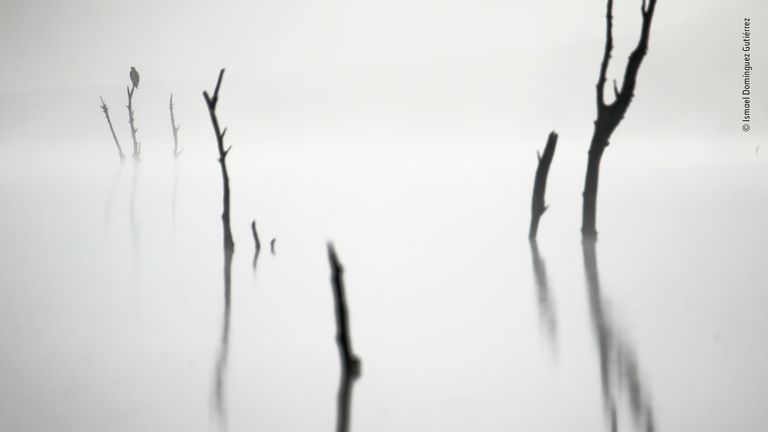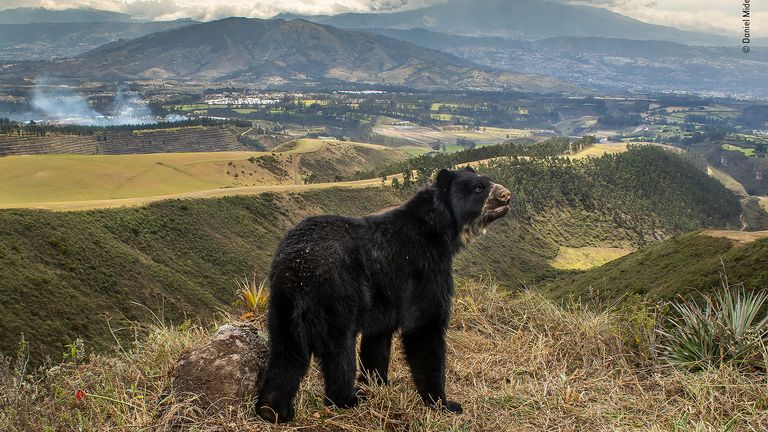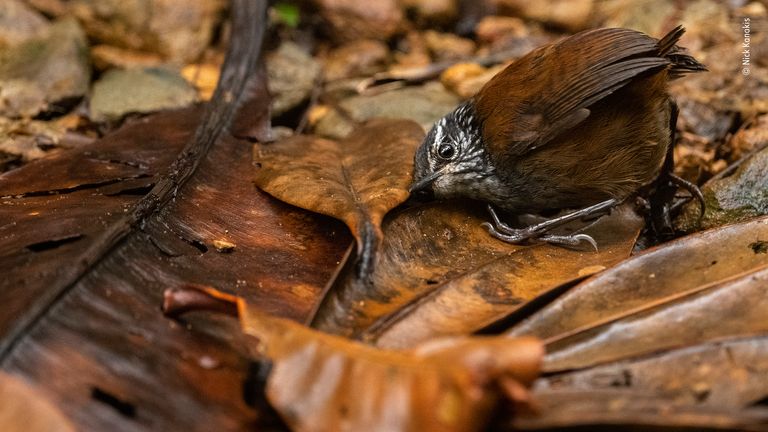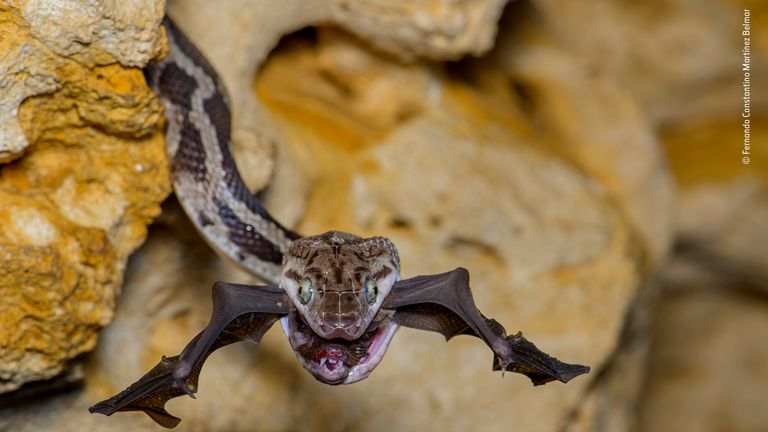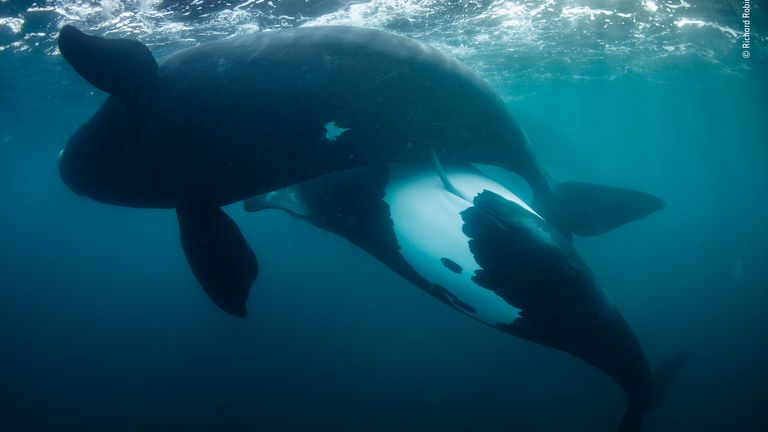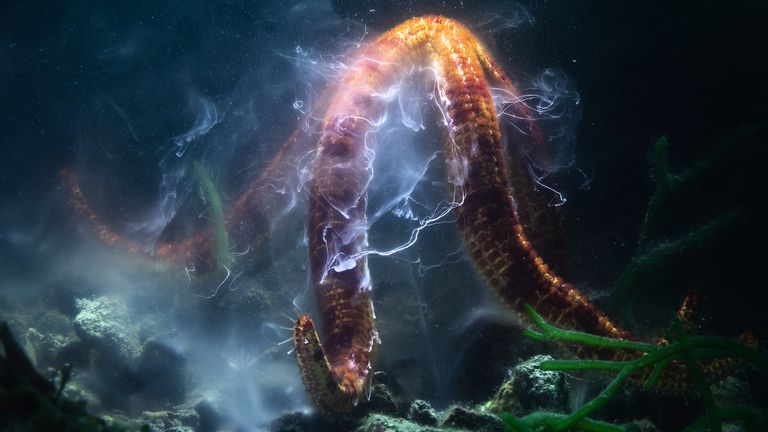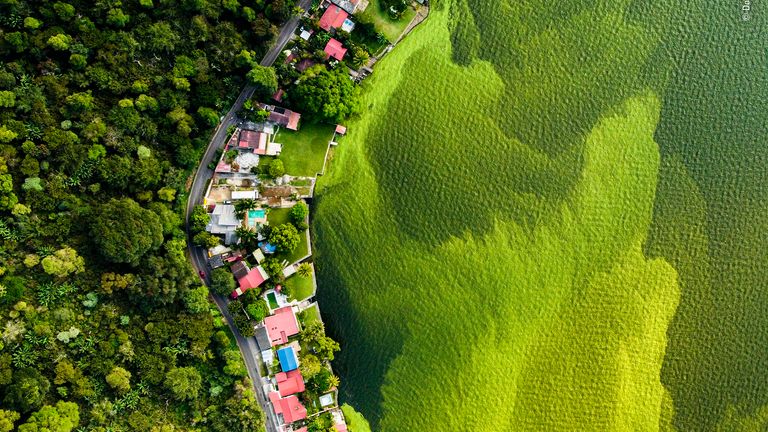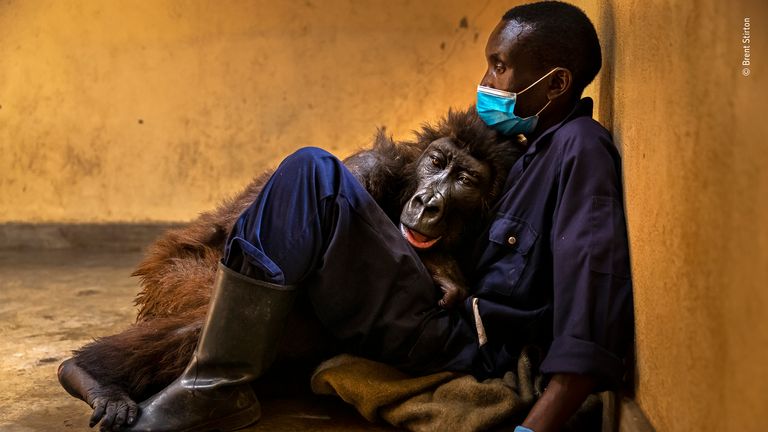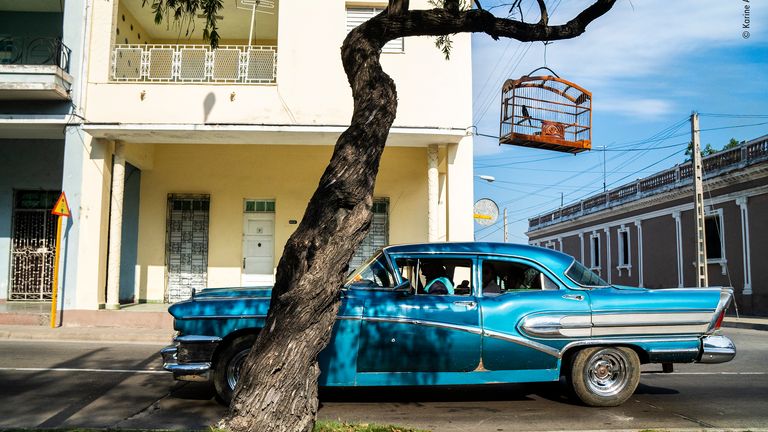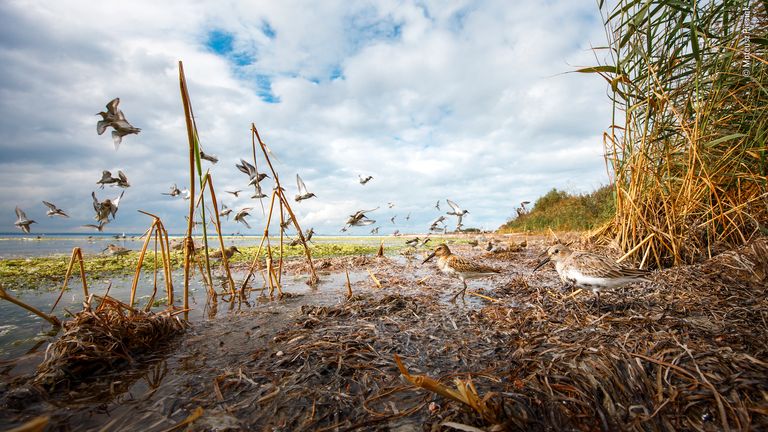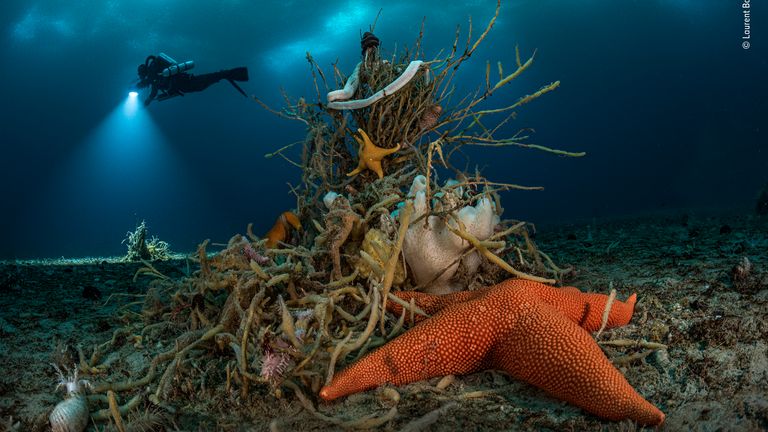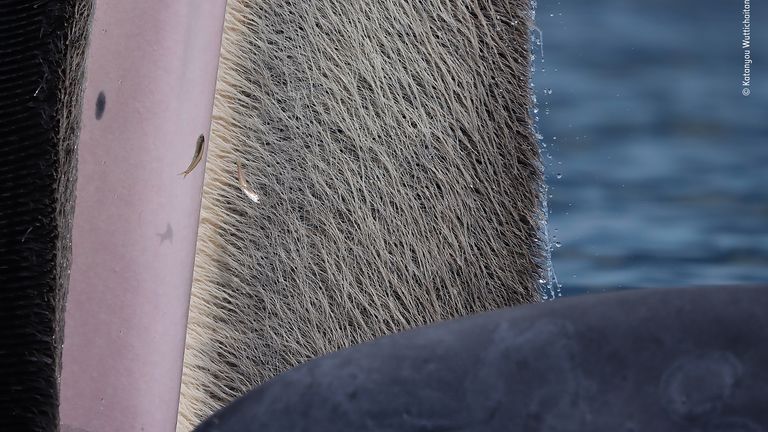
The woman behind an image of a buzzing ball of cactus bees spinning over the hot sand on a Texas ranch has been named winner of this year’s Wildlife Photographer Of The Year competition.
American photographer Karine Aigner became just the fifth woman in the competition’s 58-year history to be awarded the Grand Title award.
The winners of the Natural History Museum’s prestigious Wildlife Photographer of the Year competition were announced at an awards ceremony in London on Tuesday night.
Entitled “The big buzz”, her winning shot was taken close up at bee-level and shows all except one of the male insects intent on mating with the single female at the centre.
Organisers of the contest pointed out that, like most bees, the insects pictured are threatened by habitat loss, pesticides and climate change, along with farming practices that disrupt their nesting grounds.
Chair of the jury, writer and editor Rosamund Kidman Cox OBE, said: “Wings-whirring, incoming males home in on the ball of buzzing bees that is rolling straight into the picture.
“The sense of movement and intensity is shown at bee-level magnification and transforms what are little cactus bees into big competitors for a single female.”
Meanwhile, 16-year-old Katanyou Wuttichaitanakorn, from Thailand, was awarded the Young Wildlife Photographer of the Year 2022 for his creative image, “The beauty of baleen”.
Organisers explained that when a Bryde’s whale surfaced close to the boat, Katanyou was intrigued by the contrasting colours and textures of its dark skin, pink gum and the brush-like mass of baleen hanging down from its top jaw.
Like other baleen whales, the species use a technique known as lunge-feeding to capture large numbers of small schooling fish and use the plates of baleen to filter the small prey from the ocean.
“Out of the jaws of a Bryde’s whale comes this dazzling creation,” said Ms Kidman Cox.
“The pin-sharp detail of the tiny anchovies is set against an abstraction of colour with the weave of brown baleen hair rimmed by a cascade of water drops.”
The two Grand Title winners were chosen from 19 category winners that highlight the natural world in all its wonder and diversity.
They had been picked from a total of 38,575 entries from 93 countries to be judged anonymously by an international panel of experts on their originality, narrative, technical excellence and ethical practice.
The images will go on show as part of the redesigned Wildlife Photographer of the Year exhibition from 14 October at the Natural History Museum.
Below are the individual award winners along with their categories and descriptions:
Battle stations by Ekaterina Bee, Italy – 10 years and under
Ekaterina Bee watches as two Alpine ibex spar for supremacy. It was near the end of a spring day trip with her family that Ekaterina spotted the fight.
The two ibex clashed horns and continued to trade blows while standing on their hind legs like boxers in a ring.
In the early 1800s, following centuries of hunting, fewer than 100 Alpine ibex survived in the mountains on the Italy-France border. Successful conservation measures mean that, today, there are more than 50,000.
Out of the fog by Ismael Domínguez Gutierrez, Spain – 11 to 14 years
Ismael Domínguez Gutiérrez reveals a monochromatic scene as an osprey sits on a dead tree, waiting for the fog to lift.
When Ismael arrived at the wetland, he was disappointed not to be able to see beyond a few metres – and certainly he had no hope of glimpsing the grebes he wanted to photograph.
But as the fog began to lift, it revealed the opportunity for this striking composition.
Ospreys are winter visitors to the province of Andalucia.
Spectacled bear’s slim outlook by Daniel Mideros, Ecuador – Animals in their Environment
Daniel Mideros takes a poignant portrait of a disappearing habitat and its inhabitant.
Daniel set up camera traps along a wildlife corridor used to reach high-altitude plateaus.
He positioned the cameras to show the disappearing natural landscape with the bear framed at the heart of the image.
These bears, found from western Venezuela to Bolivia, have suffered massive declines as the result of habitat fragmentation and loss.
Puff perfect by José Juan Hernández Martinez, Spain – Animal Portraits
Jose Juan Hernández Martinez witnesses the dizzying courtship display of a Canary Islands houbara.
Jose arrived at the houbara’s courtship site at night. By the light of the moon, he dug himself a low hide.
From this vantage point he caught the bird’s full puffed-out profile as it took a brief rest from its frenzied performance.
A Canary Islands houbara male returns annually to its courtship site to perform impressive displays.
Raising the plumes from the front of its neck and throwing its head back, it will race forward before circling back, resting just seconds before starting again.
The listening bird by Nick Kanakis, USA – Behaviour: Birds
Nick Kanakis gains a glimpse into the secret life of wrens.
Nick spotted the young grey-breasted wood wren foraging. Knowing it would disappear into the forest if approached, he found a clear patch of leaf litter and waited.
Sure enough, the little bird hopped into the frame, pressing its ear to the ground to listen for small insects.
This prey-detecting technique is used by other birds, including the Eurasian blackbird.
The great cliff chase by Anand Nambiar, India – Behaviour: Mammals
Anand Nambiar captures an unusual perspective of a snow leopard charging a herd of Himalayan ibex towards a steep edge.
From a vantage point across the ravine, Anand watched the snow leopard manoeuvre uphill from the herd.
It was perfectly suited for the environment – unlike Anand, who followed a fitness regime in preparation for the high altitude and cold temperatures.
The bat-snatcher by Fernando Constantino Martinez Belmar, Mexico – Behaviour: Amphibians and Reptiles
Fernando Constantino Martinez Belmar waits in darkness as a Yucatan rat snake snaps up a bat.
Using a red light to which both bats and snakes are less sensitive, Fernando kept an eye on this Yucatan rat snake poking out of a crack.
He had just seconds to get the shot as the rat snake retreated into its crevice with its bat prey.
Heavenly flamingos by Junji Takasago, Japan – Natural Artistry
Junji Takasago powered through altitude sickness to produce a dream-like scene.
High in the Andes, Salar de Uyuni is the world’s largest salt pan. It is also one of Bolivia’s largest lithium mines, which threatens the future of these flamingos.
New life for the tohora by Richard Robinson, New Zealand – Oceans: The Bigger Picture
Richard Robinson captures a hopeful moment for a population of whales that has survived against all odds.
Hindered by poor visibility, Richard used a polecam to photograph the whales gradually moving towards his boat.
Pushing his camera to its limits in the dark water, he was relieved to find the image pin-sharp and the moment of copulation crystallised in time.
The magical morels by Agorastos Papatsanis, Greece – Plants and Fungi
Agorastos Papatsanis composes a fairy tale scene in the forests of Mount Olympus.
He waited for the sun to filter through the trees and light the water in the background, then used a wide-angle lens and flashes to highlight the morels’ labyrinthine forms.
Morels are regarded as gastronomic treasures in many parts of the world because they are difficult to cultivate, yet in some forests they flourish naturally.
Shooting star by Tony Wu, USA/Japan – Underwater
Tony Wu watches the electrifying reproductive dance of a giant sea star.
As the surrounding water filled with sperm and eggs from spawning sea stars, Tony faced several challenges.
Stuck in a small, enclosed bay with only a macro lens for photographing small subjects, he backed up to squeeze the undulating sea star into his field of view, in this galaxy-like scene.
House of bears by Dmitry Kokh, Russia – Urban Wildlife
Dmitry Kokh presents this haunting scene of polar bears shrouded in fog at the long-deserted settlement on Kolyuchin.
As they explored every window and door, Dmitry used a low-noise drone to take a picture that conjures up a post-apocalyptic future.
In the Chukchi Sea region, the normally solitary bears usually migrate further north in the summer, following the retreating sea ice they depend on for hunting seals, their main food.
The dying lake by Daniel Nunez, Guetamala Winner, Wetlands – The Bigger Picture
Daniel Nunez uses a drone to capture the contrast between the forest and the algal growth on Lake Amatitlan.
Daniel took this photograph to raise awareness of the impact of contamination on Lake Amatitlan, which takes in around 75,000 tonnes of waste from Guatemala City every year.
Ndakasi’s passing by Brent Stirton, South Africa – Photojournalism
Brent Stirton shares the closing chapter of the story of a much-loved mountain gorilla.
Brent photographed Ndakasi’s rescue as a two-month-old after her troop was brutally killed by a powerful charcoal mafia as a threat to park rangers.
Here he memorialised her passing as she lay in the arms of her rescuer and caregiver of 13 years, ranger Andre Bauma.
‘The Cuban connection’ by Karine Aigner, USA – Photojournalist Story Award
A Cuban bullfinch is positioned alongside a road so that it becomes accustomed to the hubbub of street life and therefore less likely to be distracted during a competition.
These birds are highly prized for their sweet voice and feisty spirit.
‘A theatre of birds’ by Mateusz Piesiak, Poland – Rising Star Portfolio Award
Placing his remote camera on the mud of the reed bed, Mateusz seized the opportunity to capture the moment when a passing peregrine falcon caused some of the dunlins to fly up.
‘Under Antarctic ice’ by Laurent Ballesta, France – Portfolio Award
Living towers of marine invertebrates punctuate the seabed off Adelie Land, 32 metres (105 feet) under East Antarctic ice.
Here, at the centre, a tree-shaped sponge is draped with life, from giant ribbon worms to sea stars.



